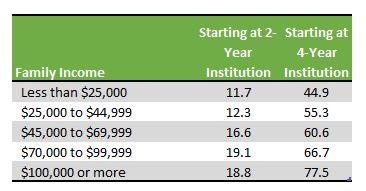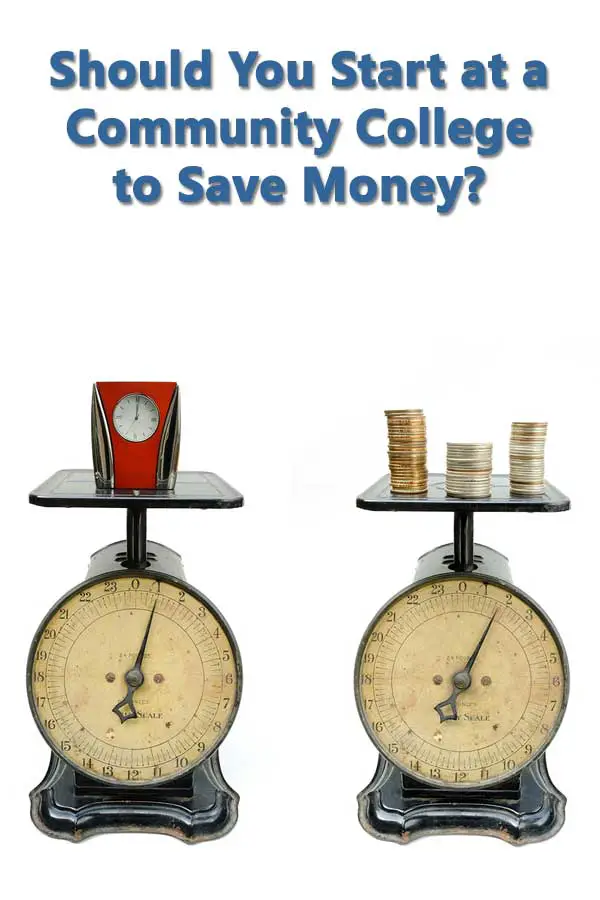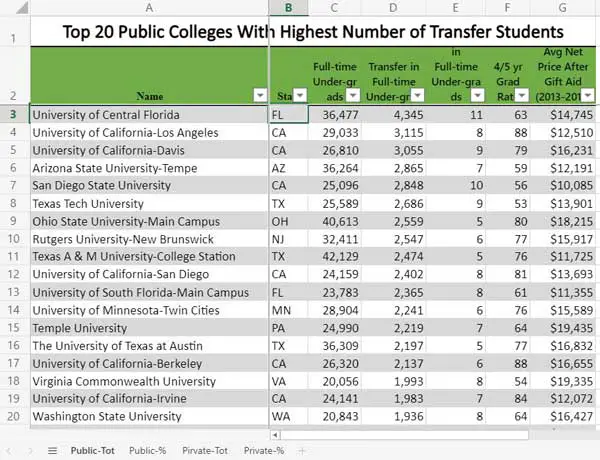 Should you start your undergraduate education at a community college to save money? As usual, there is rarely a simply yes or no answer. So many factors for college success vary from institution to institution and so much depends on the individual that any answer is going to have to be qualified.
Should you start your undergraduate education at a community college to save money? As usual, there is rarely a simply yes or no answer. So many factors for college success vary from institution to institution and so much depends on the individual that any answer is going to have to be qualified.
Despite the prospect of lower tuition, the evidence shows that all other considerations being equal, a student should enroll directly in a four-year institution. The biggest reason is that students who start at a community college are much less likely to graduate than those who start at a four-year institution.
The following data from the National Center for Education Statistics shows the percentage of students who complete a bachelor’s degree in six years according to family income and the starting institution.

Furthermore, those who start a two-year college and complete a bachelor’s degree are likely to take longer to graduate than those who start at four-year institutions. On average, students starting at a community college took 71 months to complete a bachelor’s degree compared to 55 months for those a public universities and 50 months for those at private four-year institutions.
This is not to suggest that those who attend a community college receive an inferior education. Dr. Robert Ronstadt, former vice president of Boston University argues that:
Course content is fairly standard for Math 101 or English 101. Furthermore, the odds are your community college teacher will be as competent, skilled in the classroom and dedicated as a university professor (or teaching assistant). In many instances, your community college instructors will be better.
And starting at one of the over 300 four-year institutions with four-year graduate rates of 20% or less isn’t going to do much to improve a student’s chances for a bachelor’s degree.
The fact of the matter is that in the real world, “all other considerations” are never equal and certainly vary from individual to individual. So it’s up to the individual to take a hard look at the considerations to make the best choice for him.
Cost
Pro: Community colleges are cheaper than public universities and much cheaper than private colleges. Students can save more money by living at home.
Con: If the classes don’t transfer to a four-year institution, you haven’t saved any money. Ideally, start your community college search by looking at the transfer/articulation agreements with the university you intend to transfer to.
Flexibility
Pro: Community colleges are likely to offer a variety of classes at a variety of times making it easier to work part-time.
Con:Too often students end up working more hours at the expense of dropping a class here and there. Students who don’t go full-time are much more likely not to transfer or graduate.
Classes
Pro: Community college classes are likely to be smaller than those at a public university, offering more individual attention.
Con: You may find the quality of your classes suffers because of classmates who for a variety of reasons, can’t keep up with the work and don’t contribute to the discussions.
Academic Challenge
Pro: Because of smaller classes, some community colleges do a much better job of teaching some of the more difficult prerequisites found in introductory classes at four-year universities. More community colleges also offer honor programs.
Con: Quality of classes varies from college to college so students need to be careful that they are being prepared for more advanced material. Since many of the students will be attending classes as part of their vocation program, students are likely to miss out on the academic “push” from their fellow students.
Community
Pro: For first generation college students and those from certain ethnic/cultural groups, a community college will allow the student to take advantage of his community support group to make the adjustment to college life.
Con: There’s a reason why many colleges and universities require freshman to live on campus. It puts the students in the center of the academic environment with immediate access to a variety of social and cultural opportunities.
Community College Resources
Ultimately, community college, like any other college choice, is what you make of it. Attending a community college can be the start of a great education but it won’t happen if the student doesn’t plan and take advantage of the existing opportunities.
The following resources are a must read for any student who plans to transfer from a community college.
Transfer and Articulation – All State Profiles
Listing of state transfer and articulation agreements by the Education Commission of the States.
Taking Credit: The Complete Guide to Making Sure Your Course Credits Transfer When You Do
Provides an overview of transfer issues and resources for information.
Community College Transfers as Likely to Earn a BA as Four-Year Students, Despite Credit Transfer Roadblocks
Important reminder about the need to know that credits will transfers.
Students who begin their postsecondary education at a community college and successfully transfer to a four-year college have BA graduation rates equal to similar students who begin at four-year colleges, according to new research published today. That rate would actually increase – to 54 percent from 46 percent – if not for the loss of academic credits when students transfer, said study authors
From Community College to a Bachelor’s Degree and Beyond: How Smooth Is the Road?
Federal Reserve Bank of St. Louis
A look at the financial implications of starting a community college.
Bridget Terry Long and Michal Kurlaender recently studied a group of students over a nine-year period. They found that the rates of dropping out or “stopping out” without a bachelor’s degree are much higher for those who start at community colleges than for those who start at four-year institutions.2 Community college students were 36 percent less likely to obtain a bachelor’s degree than similar students who started at four-year colleges. Moreover, among community college students who expressed an intention to obtain a four-year bachelor’s degree, only 26 percent have such a degree nine years later. On the other hand, 50 percent and 73 percent of those who start at nonselective and selective four-year institutions, respectively, obtain a bachelor’s degree within nine years. The negative effect of starting post-secondary education at a community college remains even after the authors adjust for selection bias by controlling for students’ race, gender, age, ability (measured by ACT scores) and family income. The authors suggest that “it is worth comparing the size of the penalty to the difference in costs at two-year versus four-year institutions.”
College Access, Initial College Choice and Degree Completion
National Bureau of Economic Research
“Most importantly, access to four-year public colleges substantially increases bachelor’s degree completion rates, particularly for low-income students. Conditional on a student’s own academic skill, the institutional completion rate of his initial college explains a large fraction of his own probability of completion.”
Community College to Bachelor’s
However, previous studies show that 62 percent of students who transfer from two-year to four-year institutions go on to earn bachelor’s degrees within six years of transferring, he said. The rate is even higher for students who complete a credential at the two-year college before transferring — at 72 percent.
Fewer than one in seven community college students transfer and get a bachelor’s degree — but there is new hope
Hechinger Report
But the researchers said that the approach taken by the four-year colleges was equally, if not more, significant and could increase chances of success, regardless of where the student had started.
Other Resources:
College Partnerships and Articulation Agreements
CollegeTransfer.net
U.Select
What is Academic Momentum? And Does It Matter?
Breakthrough Collaborative
Best Community College Lists
2015’s Best & Worst Community Colleges
WalletHub
Uses a reasonable methodology. List colleges ranked by cost, classroom experience, education outcomes, and career outcomes.
How does your community college stack up?
CNN Money
Basically just graduation rate or transfer rate. Could be useful when you’re trying to decide between two colleges.
The Best Community Colleges of 2015
SmartAsset
Methodology is focused on transfer/graduation rates, tuition, starting salary, and student/faculty ratio.
Community College Survey of Student Engagement
University of Texas
This data is used in WalletHub’s listing. Not all school participate but you can look up results for individual schools.
Community Colleges by Salary Potential
PayScale
Lists colleges by pay and percentage of students reporting having jobs with high meaning.
Aspen Prize for Community College Excellence
Aspen Institute
Listing of colleges nominated for the prize.
The following tables list the top 20 four-year institutions with at least a 50% graduation rate (4-year for private, 5-year for public) that have the highest percentage of transfer students and the highest number of transfer students.
Listing of Colleges with Most Transfer Students




6 thoughts on “Should You Start and Then Transfer from a Community College to Save Money?”